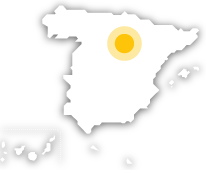Burgo de Osma, an ancient and monumental episcopal city, is situated at the foot of the Ucero River and offers one of the best-preserved medieval enclosures in the whole province of Soria. It is not for nothing that the city was listed as a historic and artistic site.
Burgo de Osma's origins date back to the primitive Arevaque settlement of Uxama, an enclave which, centuries later, would be subjected to Roman jurisdiction. However, it was during the time of the Visigoths that the town began to experience a period of splendour, as it became the episcopal see in the 6th century AD until the arrival of the Moors.Following the Muslim domination, the city regained its former capital status in the 12th century. The present-day town began to take shape in 1101, when Bishop Pedro de Bourges (San Pedro de Osma) chose a monastery located next to the Ucero River as his cathedralic seat, a fact that favoured the flourishing of a prosperous burgh of merchants and craftsmen. This privileged situation would last for centuries, to the point that in the Renaissance period it even included a university.
The medieval city
The old medieval city layout is organised around the cathedral, one of the most important religious buildings in the province. This Gothic church was built in 1232 on the site of another Romanesque church that had been begun in the time of San Pedro de Osma. On the outside, various Renaissance additions can be seen on the main façade, as well as a slender Baroque tower erected in 1739. Meanwhile, the inside of the building preserves abundant examples of the original Romanesque work of architecture, as well as a beautiful late Gothic cloister. Among its most precious treasures are the main altarpiece, a work by Juan de Juni, as well as the polychrome stone tomb of the founder, San Pedro de Osma. Visitors can see an important collection of codices in the sacristy, including the Commentary on the Apocalypse by Beatus of Liebana.Next to the cathedral is the Episcopal Palace, a building with an intriguing late Gothic façade. We are right in the heart of Calle Mayor, one of the main thoroughfares of the old town centre. On this typical road you can admire one of the most classic views of Burgo de Osma: the old houses supported by stone-columned arcades.The main square, Plaza Mayor also has a Porticoed appearance, where 18th-century buildings such as the City Hall and San Agustin Hospital stand, the latter with two towers with spires flanking its main façade.The city's historic ramparts were built by Bishop Pedro de Montoya in the 15th century. The Puerta de San Miguel, which is still preserved, is one of several gates that allowed access to the medieval town.Outside the walls, the 16th-century University of Santa Catalina is located in the immediate vicinity. The building was constructed thanks to the patronage of the Portuguese bishop Pedro Álvarez D'Acosta. Its Renaissance façade features an image of Santa Catalina, as well as a beautiful interior courtyard.The famous Roman bridge still stands over the course of the river Ucero and, on a nearby hill, the ancient Castle of Osma overlooks the surroundings of El Burgo. Its outer enclosure and water tower date from the second half of the 15th century, although there is evidence of earlier fortifications in the city, as early as the 8th century, as this enclave was located in border territory between Moors and Christians.In this town you can enjoy succulent gastronomy, best paired with typical products of the traditional pig slaughter. To sample them, the best thing you can do is to attend the annual ritual slaughter gastronomic events organised by the Hotel Virrey Palafox, which has been declared to be of Tourist Interest. These events are held on weekends in February and March and offer a wide variety of cured meats and sausages and other pork products.Game dishes (partridge, hare, quail, etc.) and fish (trout and crayfish) are also typical. That's not to mention the vegetables from the market garden of the river Ucero, especially the cardoon and beans from El Burgo. Meanwhile, the autumn season offers the chanterelle mushrooms and thistle mushrooms.Burgo de Osma shares other culinary specialities with the rest of the region of Castile, such as lamb – grilled, roast or in a stew – or “cocido castellano” (a stew with chickpeas, pork, chorizo and more).And to top it all off, the city's excellent confectionery includes sweets such as “harinados” or “sobadillos hojaldrados” (flaky pastries).
Surrounding area
The surroundings of El Burgo de Osma invite you to discover an environment of enormous ecological value. The Cañón del río Lobos, declared a nature reserve, has numerous caves and rocky cliffs where eagles and griffon vultures nest. Inside this park, you will also find the Romanesque-style Hermitage of San Bartolomé, a Templar hermitage.The city forms part of the Douro route, which crosses through other towns in Soria. Almazán stands out for its historic quarter, known for the main square Plaza Mayor, the three gates of the city walls and several churches. Berlanga de Duero preserves the Castle of the Tovar (15th century), a bastion that still has two walls and a castle keep, and the church-collegiate church of Nuestra Señora del Mercado, in Gothic-Renaissance style.Following the course of the Duero River, we find San Esteban de Gormaz, an ancient fortified town, and Ucero, with the walls of its medieval castle rising above it. The route is not complete without a visit to Gormaz to see its castle, which is considered the largest caliphal fortress in Europe, and Calatañazor, which boasts the Romanesque-style Church of Nuestra Señora del Castillo as well as the city walls, built between the 12th and 13th centuries.When it comes to accommodation, El Burgo de Osma has several hotels. Another option is to go to the capital of Soria, where you will find the Tourist Parador. Located in the Parque del Castillo, this Parador offers you one of the best panoramic views of the capital and the Duero River.
















